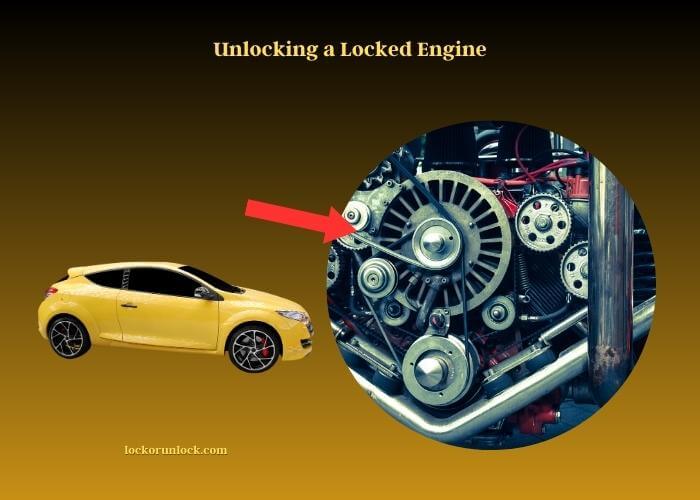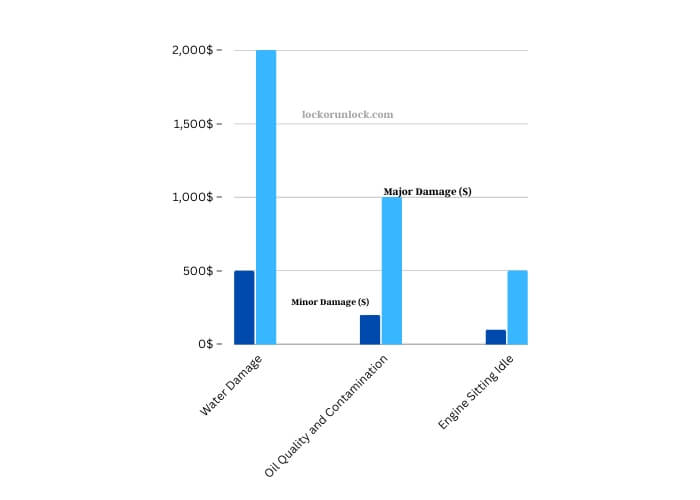Yes, it is possible to unlock a locked engine, but the process and success depend on the cause of the seizure. If you’ve driven through a deep puddle, remove the spark plug, fill it with oil, and let it sit for 24 hours. You may then be able to free it with a breaker bar.
An engine can lock up or seize for several reasons, and the repair cost will vary depending on the cause. For example, an engine can still seize even with oil in it, especially if the oil is old or contaminated, preventing it from properly lubricating the engine parts.
Some common symptoms of a locked engine include a sudden stop while driving, inability to start the vehicle, and strange noises from the engine. It is also possible to mistake a bad starter for a seized engine, as both can prevent the vehicle from starting.
Moreover, an engine can seize from sitting for too long, as oil drains away from the components, and it can take as little as a few months for this to happen. A seized engine may or may not turn over, depending on the severity of the damage.

If you suspect that your engine is locked up, it’s crucial to address the issue right away to prevent further damage. To learn more about this topic, read the detailed article below.
Can You Unlock a Locked Engine? Easy Solutions!
Worried about your car engine locking up? It’s a common fear for many vehicle owners, especially those with older models. Can you unlock a locked engine? Yes, it is possible, and this article will guide you through the process, from identifying the symptoms to the different methods you can use to unlock it.
Identifying a Locked Engine
Common Symptoms of a Locked Engine
The first step to resolving any issue is recognizing that there is one. An engine can lock up for various reasons, and knowing the symptoms can save you a lot of trouble down the road. If your vehicle suddenly stops while driving, refuses to start, or you hear strange noises from the engine, it could indicate a locked engine. Keep an ear out for any unusual sounds like knocking or clanging, as these are clear signs that something is wrong.
Differentiating Between a Bad Starter and a Seized Engine
Sometimes it’s easy to mistake a bad starter for a seized engine since both prevent the vehicle from starting. A bad starter will typically make a clicking noise when you turn the key, while a seized engine will make a clunking sound and not turn over at all. Knowing the difference can save you time and money by addressing the right issue.
Causes of Engine Seizure
Running Through a Deep Puddle
Driving through deep water can cause your engine to seize. Water can enter the engine compartment and cause the engine components to lock up. It’s always best to avoid driving through deep water if possible.
Oil Quality and Contamination
Even with oil in the engine, it can still seize if the oil is old or contaminated. Oil is essential for lubricating the engine parts, and if it’s not doing its job, it can lead to engine seizure. Regularly changing your oil and using a high-quality product can help prevent this.
Engine Sitting Idle for Extended Periods
Leaving your vehicle sitting idle for an extended period can also lead to engine seizure. Oil drains away from the components over time, and without regular use, the engine parts can lock up. It can take as little as a few months for this to happen, so it’s crucial to start and run your vehicle regularly.
Repair Costs for Locked Engines
Average Repair Costs by Cause and Severity
Unlocking a locked engine can be expensive, depending on the cause and severity of the damage. Here’s a table summarizing the average repair costs by cause and severity:
| Cause | Minor Damage ($) | Major Damage ($) |
| Water Damage | 500 – 1,000 | 2,000 – 4,000 |
| Oil Quality and Contamination | 200 – 500 | 1,000 – 2,000 |
| Engine Sitting Idle | 100 – 300 | 500 – 1,000 |
Note: These are average costs and may vary depending on your location and the make and model of your vehicle.

DIY Methods to Unlock a Locked Engine
Removing Spark Plug and Using Oil
One DIY method to unlock a locked engine involves removing the spark plug, filling the cylinder with oil, and letting it sit for 24 hours. This helps to lubricate the piston and cylinder walls and may allow you to free the engine with a breaker bar.
Using a Breaker Bar
A breaker bar is a long non-ratcheting bar that is used for loosening stuck bolts and nuts. If the engine is locked due to rust or corrosion, you can try to unlock it by attaching a breaker bar to the crankshaft pulley bolt and applying steady force.
Professional Intervention for Engine Unlocking
Scenarios Where Professional Help is Necessary
While there are some DIY methods to unlock a locked engine, there are situations where professional help is necessary. For example, if the engine is severely damaged due to water ingestion or if there is significant internal damage, it’s best to seek help from a professional mechanic.
Finding a Reliable Mechanic
Finding a reliable mechanic is crucial for unlocking a locked engine. Ask for recommendations from friends and family or read online reviews to find a trustworthy mechanic in your area. Make sure to get a detailed estimate before any work is done.
Preventing Engine Seizure
Regular Maintenance and Inspection
Regular maintenance and inspection of your vehicle are essential for preventing engine seizure. Make sure to change your oil regularly, check for any leaks, and address any unusual noises or vibrations as soon as possible.
Proper Storage of Vehicles
If you plan to store your vehicle for an extended period, it’s crucial to take proper precautions to prevent engine seizure. Make sure to change the oil, remove the spark plugs, and spray oil into the cylinders before storage. Also, it’s a good idea to turn the engine over by hand every few weeks to keep the parts lubricated.
Real-Life Cases of Engine Unlocking
Case Study 1: Engine Locked Up While Driving
In one instance, a vehicle owner was driving on the highway when their engine suddenly locked up. They had recently driven through a deep puddle, which caused water to enter the engine compartment and seize the engine. With the help of a mechanic, they were able to unlock the engine by removing the spark plugs and draining the water from the cylinders.
Case Study 2: Engine Seized from Sitting
Another case involved a vehicle that had been sitting idle for several months. The owner tried to start it, but the engine was seized. They removed the spark plugs, filled the cylinders with oil, and let it sit for 24 hours. They were then able to free the engine with a breaker bar.
Engine Unlocking Calculator
A cost calculator for engine unlocking can be helpful for vehicle owners to estimate the repair costs:
FAQs
Can a Locked Engine Be Fixed?
Yes, a locked engine can be fixed, but the extent of the damage will determine if it is worth repairing. Minor damage may require only the replacement of a few parts, whereas severe damage may necessitate a complete engine rebuild or replacement.
How Much Does It Cost to Fix a Seized Engine?
The cost to fix a seized engine varies depending on the cause and extent of the damage. Minor damages can cost between $200-$500, while major damages can range from $1000-$4000. It’s advisable to get a detailed estimate from a mechanic.
How Do I Know If My Engine Is Locked Up?
If your engine is locked up, it will not turn over or make a clunking sound when you try to start it. Other symptoms include a sudden stop while driving, inability to start the car, and unusual noises like knocking or clanging from the engine.
Can an Engine Seize While Driving?
Yes, an engine can seize while driving. This can happen if there is a lack of oil, causing excessive friction between the engine components, or if water enters the engine compartment and locks up the engine.
How Do You Know If Your Engine Locked Up?
If your engine is locked up, you may experience the following symptoms: The vehicle suddenly stops while driving, refusal to start, and unusual noises like knocking or clanging from the engine. The engine will also not turn over when you try to start it.
What Are the Signs of Engine Locking Up?
Signs of an engine locking up include unusual noises like knocking or clanging from the engine, the vehicle suddenly stopping while driving, refusal to start, and the engine not turning over when trying to start the vehicle.
How to Start a Seized Engine?
To start a seized engine, you can try removing the spark plugs and filling the cylinders with oil. Let it sit for 24 hours, then try to turn the engine over with a breaker bar. If the engine is still locked up, it’s best to seek professional help.
Summary
Unlocking a locked engine can be a daunting task, but it is possible with the right knowledge and tools. Whether you choose to tackle the issue yourself or seek professional help, it’s essential to address the problem promptly to avoid further damage and costs. Regular maintenance and proper storage of your vehicle can help prevent engine seizure in the first place. Remember to consult a professional if you are unsure about any step in the process or if the damage is severe.
You May Also Like:
- Can You Successfully Drill Out a Master Lock? An In-Depth Guide
- Can You Switch Off Automatic Door Locks? A Full Guide
- Solutions Guide: Dodge Ram Door Lock Not Working Issues
- Troubleshooting the 2017 Hyundai Elantra: Why Your Door Won’t Open from Outside
- 2014 Chevy Impala Door Lock Problems: A Detailed Overview
